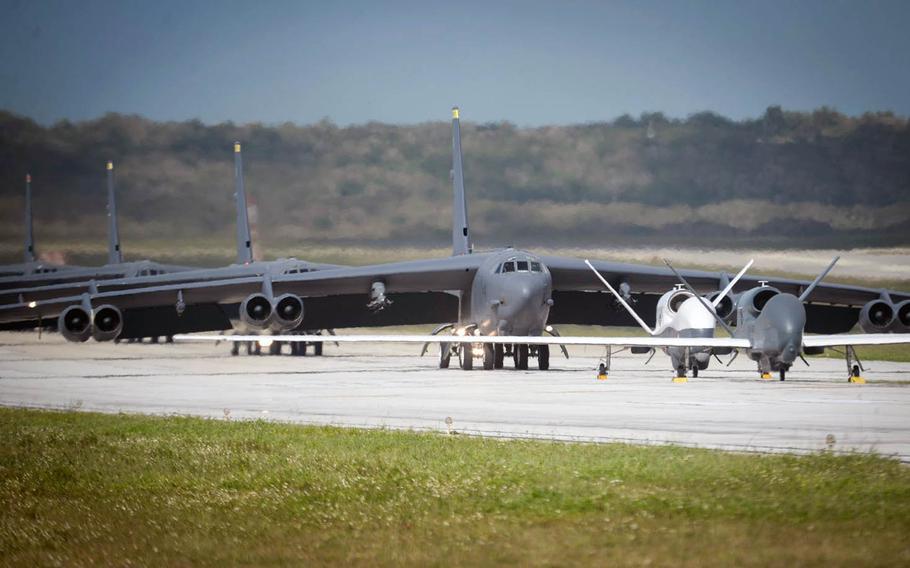
An Air Force RQ-4 Global Hawk, a Navy MQ-4C Triton and Air Force B-52 Stratofortresses line up for an "elephant walk" at Andersen Air Force Base, Guam, on Monday, April 13, 2020. (Divine Cox/U.S. Air Force)
With the USS Theodore Roosevelt sidelined nearby due to the coronavirus, the U.S. military on Guam exhibited a reminder of its deep bench this week in a region where global powers compete.
Fourteen aircraft paraded in a formation known as an “elephant walk” along the runway at Andersen Air Force Base on Monday. Among them were five B-52 Stratofortress strategic bombers; six KC-135 Stratotanker aerial refuelers; an MH-60S Knighthawk helicopter; and two unmanned aerial vehicles: an Air Force RQ-4 Global Hawk and a Navy MQ-4C Triton.
The elephant walk was meant to demonstrate the ability to “generate combat airpower at a moment’s notice to ensure regional stability throughout the Indo-Pacific,” according to the 36th Wing website.
The display was likely directed at China and North Korea, according to former Air Force officer Ralph Cossa, now an adviser for the Pacific Forum think tank in Hawaii.
“They want to signal that, despite the problems with the carrier, we still have forces with the ability to respond,” Cossa said Wednesday. “We want to show we are still ready to respond.”
Over the weekend, China’s Liaoning aircraft carrier passed between the Japanese islands of Okinawa and Miyako and east of Taiwan. The voyage showed that coronavirus has not impacted Beijing’s carrier like it has those of the U.S. Navy, an unnamed Chinese military expert said Monday in the country’s state-run Global Times newspaper.
However, Cossa said the Liaoning isn’t a real threat to U.S. forces in the region.
“Chinese aircraft carriers don’t make me lose a lot of sleep,” he said. “I wouldn’t want to be on one in a fight with the U.S. Navy.”
A day after the Guam elephant walk, North Korean fighter jets fired missiles into the sea off the country’s eastern coast while units launched a salvo of cruise missiles from the ground, according to South Korea’s military.
“Nothing gets the North Koreans’ attention like B-52s,” Cossa said.
The Roosevelt remains in Guam, where four more sailors infected with coronavirus have been hospitalized, the Navy announced Tuesday, one day after a crew member died from the illness.
robson.seth@stripes.com Twitter: @SethRobson1